United States
The United States of America is a country of the western hemisphere, comprising 50 states and several territories. Forty-eight contiguous states lie in central North America between the Pacific and Atlantic Oceans, bounded on land by Canada to the north and Mexico to the south; Alaska is in the northwest of the continent with Canada to its north, and Hawaii is in the mid-Pacific.[2] The United States is a federal constitutional republic with Washington, D.C. as its capital.[3]
At over 3.7 million square miles (over 9.6 million km²) and with more than 300 million people, the United States is the third or fourth largest country by total area and third largest by population.[4] American society is the product of large-scale immigration and is home to a complex social structure[5] as well as a wide array of household arrangements.[6] The U.S. is one of the world's most ethnically and socially diverse nations.[7] The United States had the largest national economy with a GDP of over $13 trillion, constituting 22% of gross world product.[8] In terms of GDP per capita the US ranks 3rd and 8th, depending on measurement.[9]
The nation was founded by thirteen colonies of Great Britain who issued the Declaration of Independence from on July 4, 1776. It adopted the current constitution (which has been amended several times subsequently) on September 17, 1787. The country greatly expanded in territory throughout the 19th century, acquiring further territory from France, Mexico, Spain, and Russia. The United States became one of two major superpowers due to its role in World War II and its development of nuclear weapons. The remaining superpower after the collapse of the Soviet Union, the United States continues to exert dominant economic, political, cultural, and military influence around the globe.[10]
Etymology
Common names and abbreviations of the United States of America include the United States, the U.S., the U.S.A., the U.S. of A., the States (informal), and America (colloquially). The earliest known use of the name America is attributed to the German cartographer Martin Waldseemüller who, while working in Saint-Dié-des-Vosges in 1507, created a globe and a large map showing North and South America.[11] According to the Library of Congress "Waldseemüller christened the new lands "America" in recognition of Amerigo Vespucci’s understanding that a new continent had been uncovered as a result of the voyages of Columbus and other explorers in the late fifteenth century."[12] The designation the States is most often used by citizens of the United States when contrasting their country with other countries, especially when those speakers are abroad, as in the sentence "Things are more expensive here than they are back in the States." U.S. of A is not especially common in the United States itself, but it is heard frequently in other English-speaking countries.
The Americas were also known as Columbia, after Columbus, prompting the name District of Columbia for the land set aside as the U.S. capital. Columbia remained a popular name for the United States until the early 20th century, when it fell into relative disuse; it is still used poetically, and appears in various names and titles.[13][14] One female personification of the country is called Columbia.[15]
The full name of the country was first used officially in the Declaration of Independence, which was the "unanimous Declaration of the thirteen united States of America" adopted by the "Representatives of the united States of America" on July 4, 1776. On November 15, 1777, the Second Continental Congress adopted the Articles of Confederation, the first of which stated "The Stile of this Confederacy shall be 'The United States of America.'" The name was originally proposed by Thomas Paine.
The most common adjectival and demonymic form for the United States is American. This term is used to designate U.S. citizens who are abroad, and for cultural characteristics ("American language," "American sports") and is rarely (at least not in English) used to refer to people not connected to the U.S. The word "American" has been especially controversial in Latin America, where Spanish and Portuguese speakers refer to themselves as "americanos" and use the adjective "estadounidense" to describe a person from the United States.[16]
Geography
The United States is the world's third largest country by land area after Russia and China and just ahead of Canada.[17] By total area, including inland bodies of water, it is either the world's third or fourth largest nation. The Continental United States are bounded by the North Atlantic Ocean to the east, the North Pacific Ocean to the west, Mexico and the Gulf of Mexico to the south, and Canada to the north. Alaska, the largest state in area, is bound by Canada to its east, the Pacific Ocean to its south, the Arctic Ocean to its north, and the Bering Strait to the west. The state of Hawaii occupies an archipelago in the Pacific Ocean, southwest of the North American mainland. Several territories , such as Puerto Rico and Guam, are largely held for their past or present strategic value to the military.
Deciduous vegetation and grasslands prevail in the eastern U.S., transitioning to prairies, boreal forests, and the Rocky Mountains in the west, and deserts in the southwest. In the northeast, the coasts of the Great Lakes and Atlantic seaboard host much of the country's population.
Terrain
The U.S. has an extremely varied geography. The eastern seaboard has a coastal plain which is widest in the south and narrows in the north. The coastal plain does not exist north of New Jersey, although there are glacial outwash plains on Long Island, Martha's Vineyard, and Nantucket. In the extreme southeast, Florida is home to the ecologically unique Everglades.
Beyond the coastal plain, the rolling hills of the Piedmont region end at the Appalachian Mountains, which rise above 6,000 feet (1,830 m) in North Carolina, Tennessee, and New Hampshire. From the west slope of the Appalachians, the Interior Plains of the Midwest are relatively flat and are the location of the Great Lakes as well as the Mississippi-Missouri River, the world's 4th longest river system.[18] West of the Mississippi River, the Interior Plains slope uphill and blend into the vast and often featureless Great Plains.
The abrupt rise of the Rocky Mountains, at the western edge of the Great Plains, extends north to south across the continental U.S., reaching altitudes higher than 14,000 feet (4,270 m) in Colorado.[19] In the past, the Rocky Mountains had a higher level of volcanic activity; nowadays, the range only has one area of volcanism (the supervolcano underlying Yellowstone National Park in Wyoming, possibly the world's largest volcano), although rift volcanism has occurred relatively recently near the Rockies' southern margin in New Mexico.[20]
Its newest states, Alaska and Hawaii, add considerably to the diversity of the nation's terrain. Alaska has numerous mountain ranges, one of which include Mount McKinley (Denali), the highest peak in North America. Numerous volcanoes can be found throughout the Alexander and Aleutian Islands extending south and west of the Alaskan mainland. The Hawaiian Islands are tropical, volcanic islands spanning 1,500 miles (2,400 km), and consisting of six larger islands and another dozen smaller ones that are inhabited.
Climate
Due to its large size and wide range of geographic features, the United States contains examples of nearly every global climate. The climate is temperate in most areas, tropical in Hawaii and southern Florida, polar in Alaska, semiarid in the Great Plains west of the 100th meridian, desert in the Southwest, Mediterranean in coastal California, and arid in the Great Basin. Extreme weather is not uncommon, as the states bordering the Gulf of Mexico are prone to hurricanes and most of the world's tornadoes occur within the Continental United States.[21] That said, infrequent severe drought in the major agricultural regions, a general lack of widespread flooding, and a mainly temperate climate that receives adequate precipitation helped make the nation a world leader in agriculture.
History
Native Americans
Before the European colonization of the Americas, a process that began at the end of the 15th century, the present-day continental U.S. was inhabited exclusively by various indigenous peoples, including Alaskan natives, who migrated to the continent over a period that may have begun 35,000 years ago and may have ended as recently as 11,000 years ago.[22] Several indigenous communities developed advanced agriculture, grand architecture, and state level Pre-Columbian societies. However, first contact between Native Americans and early Spanish explorers spread epidemics that killed a large portion of the indigenous population. [23] These epidemics combined with violence by European settlers to marginalize the Native American population in the United States.
European colonization
The first confirmed European landing in present-day United States territory was by Christopher Columbus, who visited Puerto Rico on November 19, 1493. Florida was home to the earliest European colonies on the mainland; of these colonies only St. Augustine, which was founded by Pedro Menéndez de Avilés in 1565, remains.
A hundred or so French fur traders set up small outposts in the Great Lakes region. A few thousand Spanish settled in New Mexico and California, as well as other parts of the Southwestern United States. The first successful English settlement was at Jamestown, Virginia, in 1607, followed in 1620 by the Pilgrims' landing at Plymouth, Massachusetts. In 1609 and 1617, respectively, the Dutch settled in part of what became New York and New Jersey. In 1638, the Swedes founded New Sweden, in part of what became Delaware, New Jersey, and Pennsylvania after passing through Dutch hands. Throughout the 17th and early 18th centuries, England (and later Great Britain) established new colonies, took over Dutch colonies, and split others. Britain's Seven Years War spilled over into the French and Indian War that won Britain the bulk of Canada.
Several colonies were used as penal settlements from the 1620s until the American Revolution. With the division of the Carolinas in 1729 and the colonization of Georgia in 1732, the 13 British colonies that became the United States of America in 1776 were established and all had active local and colonial governments with elections open to most free men, with a growing devotion to the ancient rights of Englishmen and a sense of self government that stimulated support for republicanism. By the 1770s, the colonies were becoming "Anglicized" (that is, more like England). With high birth rates, low death rates, and steady immigration, the colonies doubled in population every 25 years. By 1770, they had a population of three million, approximately half as many as that of Britain itself. However, they were given no representation in the Parliament of the United Kingdom.
War for Independence and early republic

Tensions between American colonials and the British during the revolutionary period of the 1760s and 1770s led to open warfare 1775-1781. George Washington commanded the Continental Army during the American Revolutionary War (1775–1783) as the Second Continental Congress adopted the Declaration of Independence on July 4, 1776. The Congress had been formed to confront British actions and created the Continental Army, but it was handicapped by lack of authority to levy taxes; instead, it printed enough paper money to trigger hyper-inflation. During the conflict, some 70,000 loyalists to the British Crown fled the new nation, with some 50,000 United Empire Loyalist refugees fleeing to Nova Scotia and the new British holdings in Canada. [24]
In 1777, the Congress adopted the Articles of Confederation, uniting the states under a weak federal government, which operated until 1788. After the United States defeated Great Britain, dissatisfaction with the weakness of the national government led to a constitutional convention in 1787. By June of 1788, enough states had ratified the United States Constitution to establish the new government, which took office in 1789. The Constitution, which strengthened the union and the federal government, has since remained the supreme law of the land.[25]
Westward expansion
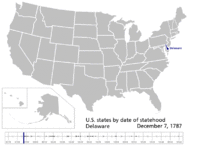
From 1803 to 1848, the size of the new nation nearly tripled as settlers (many embracing the concept of Manifest Destiny as an inevitable consequence of American exceptionalism) pushed beyond national boundaries even before the Louisiana Purchase.[26] The expansion was tempered somewhat by the stalemate in the War of 1812, but it was subsequently reinvigorated by victory in the Mexican-American War in 1848, and the prospect of gold during the California Gold Rush (1848-1849).
Between 1830–1880, up to 40 million American Bison, commonly called Buffalo, were slaughtered for skins and meat, and to aid railway expansion. The expansion of the railways reduced transit times for both goods and people, made westward expansion less arduous for the pioneers, and increased conflicts with the Native Americans regarding the land and its uses. The loss of the bison, a primary resource for the plains Indians, added to the pressures on native cultures and individuals for survival.
Civil War

As new territories were being incorporated, the nation was divided on the issue of states' rights, the role of the federal government, and the expansion of slavery, which had been legal in all thirteen colonies but was rarer in the north, where it was abolished by 1804. The Northern states were opposed to the expansion of slavery whereas the Southern states saw the opposition as an attack on their way of life, since their economy was dependent on slave labor. The failure to resolve these issues led to the American Civil War, following the secession of many slave states in the South to form the Confederate States of America after the 1860 election of Abraham Lincoln.[27] The 1865 Union victory in the Civil War effectively ended slavery and settled the question of whether a state had the right to secede. The event was a major turning point in American history and resulted in an increase in federal power.[28]
Reconstruction and industrialization

After the Civil War, an unprecedented influx of immigrants hastened the country's rise to international power. These immigrants helped to provide labor for American industry and create diverse communities in undeveloped areas together with high tariff protections, national infrastructure building and national banking regulations. The growing power of the United States enabled it to acquire new territories, including the annexation of Puerto Rico and the Philippines after victory in the Spanish-American War,[29] which marked the debut of the United States as a major world power.
World Wars and The Great Depression

At the outbreak of World War I in 1914, the United States remained neutral. In 1917, however, the United States joined the Allied Powers, helping to turn the tide against the Central Powers. For historical reasons, American sympathies favored the British and French, although many citizens, mostly Irish and German, were opposed to intervention.[30] After the war, the Senate did not ratify the Treaty of Versailles because of a fear that it would pull the United States into European affairs. Instead, the country continued to pursue its policy of unilateralism that bordered at times on isolationism.[31]
During most of the 1920s, the United States enjoyed a period of unbalanced prosperity as farm profits fell while industrial profits grew. A rise in debt and an inflated stock market culmination in a crash in 1929, combined with the Dust Bowl, triggered the Great Depression. After his election as President in 1932, Franklin Delano Roosevelt launched his New Deal policies increasing government intervention in the economy in response to the Great Depression.
The nation would not fully recover from the economic depression until it's industrial mobilisation related to entering World War II. On December 7, 1941 the United States was driven to join the Allies against the Axis Powers after a surprise attack on Pearl Harbor by Japan. World War II was the costliest war in economic terms in American history,[32][33] but it helped to pull the economy out of depression because the required production of military material provided much-needed jobs, and women entered the workforce in large numbers for the first time.
During this war, the United States became the first nuclear power following the success of the Manhattan Project. To bring about a quick end to World War II and forgo a land-invasion of Japan, the United States dropped nuclear weapons on Hiroshima and Nagasaki, Japan, in August of 1945. The Hiroshima and Nagasaki bombs were the second and third nuclear devices detonated and the only ones ever used in war. Japan surrendered soon after, on September 2, 1945, ending World War II.[34]
Cold War and civil rights
After World War II, the United States and the Soviet Union became superpowers in an era of ideological rivalry dubbed the Cold War. Through the North Atlantic Treaty Organization and the Warsaw Pact, the United States and the Soviet Union gained considerable power over military affairs in Europe. The United States officially promoted liberal democracy and capitalism, while the Soviet Union officially promoted communism and a centrally planned economy. Both sides sometimes supported dictatorships when politically convenient, leading to proxy wars, including the Korean War, the Vietnam War, the tense nuclear showdown of the Cuban Missile Crisis, and the Soviet war in Afghanistan.
The Soviet Union beat the United States to launch the first manned space probe, prompting an effort to raise proficiency in mathematics and science in American schools[35] and led to President John F. Kennedy's call for the United States to be first to land "a man on the moon" by the end of the 1960s, which was realized in 1969.[35] Meanwhile, America experienced a period of sustained economic expansion. A growing civil-rights movement headed by prominent African Americans such as Martin Luther King, Jr. fought racism, leading to the abolition of the Jim Crow laws in the South.[36]
While the Soviet Union collapsed and Russian power diminished in the late 1980s and 1990s, the United States continued to intervene in overseas military conflicts. The leadership role taken by the United States and its allies in the United Nations sanctioned Gulf War and the Yugoslav wars helped to preserve its position as the world's last remaining superpower and to expand NATO.
War on Terrorism
After the terrorist attacks of September 11, 2001, which killed nearly 3,000 people, U.S. foreign policy focused on the global threat of terrorism, and the government under President George W. Bush began a series of military and legal operations termed the War on Terror. It led a NATO invasion of Afghanistan which led to the removal of the Taliban from power the closure of al-Qaeda terrorist training camps. As of 2007, Taliban insurgents continue to fight a guerrilla war. The administration formed a preemptive policy against threats to U.S. security known as the Bush Doctrine.
In his 2002 State of the Union address, President George W. Bush labeled North Korea, Iraq and Iran the "axis of evil," and stated that these countries "constitute a grave threat to the security of the U.S. and its allies."[citation needed] Later that year, the Bush administration pressed for regime change in Iraq on controversial grounds. In 2003, a Coalition of the Willing invaded Iraq and occupied it, removing President Saddam Hussein.
Politics
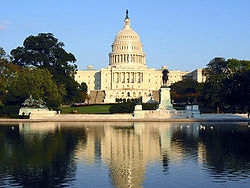
The United States is the world's oldest surviving federation, a representative democracy with a government regulated by a system of checks and balances defined by the United States Constitution. The 1789 constitution replaced the Articles of Confederation, which was in effect from 1781-1789. However, it is "not a simple representative democracy, but a constitutional republic in which majority rule is tempered by minority rights protected by law."[37] Citizens are usually subject to three levels of government, at federal, state, and local levels, although most areas are also subject to multiple local governments, such as county or metropolitan governments in addition to municipal government. Officials at all three levels are either elected by voters in a secret ballot or appointed by other elected officials. Executive and legislative offices are decided by a plurality vote of citizens in their respective districts. Judicial and cabinet-level offices are nominated by the Executive branch and approved by the Legislature in the federal government and most states, although some state judges are elected by popular vote.

The federal government comprises three branches, which are designed to check and balance one another's powers:
- Legislative: The bicameral Congress, made up of the Senate and the House of Representatives, which makes federal law, declares war, approves treaties and has powers of impeachment and the purse.
- Executive: The President, who appoints, with Senate approval, the Cabinet and other officers, who administers and enforces federal law, can veto bills, and is Commander in Chief of the military.
- Judiciary: The Supreme Court and lower federal courts, whose judges are appointed by the President with Senate approval, which interpret laws and can overturn laws they deem unconstitutional.
The United States Constitution is the supreme legal document in the American system, and serves as a social contract for the people of the United States, regulating their affairs through government chosen by and populated by the people. All laws and procedures of both state and federal governments are subject to review, and any law ruled by the judicial branch to be in violation of the Constitution is overturned. The Constitution can be amended by two methods, both of which require the approval of three-fourths of the states. The Constitution has been amended 27 times, the last time in 1992.
The Constitution contains a number of amendments, including the "Bill of Rights," which guarantee freedom of speech, religion, and the press; the right to a fair trial; the right to keep and bear arms; universal suffrage; and property rights. However, the extent to which these rights are protected and universal in practice is heavily debated. The Constitution also guarantees to every State "a Republican Form of Government". However, the meaning of that guarantee has been only slightly explicated.[38] The Constitution also defines term limits for the President and the size of the Congress. The House of Representatives has 435 members, each representing a congressional district for a two-year term. House seats are apportioned among the states according to population every tenth year. As of the 2000 census, seven states have the minimum of one representative; California, the most populous state, has 53. Each state has two senators, elected at large to six-year terms; one third of Senate seats are up for election every second year.
American politics is dominated by the Republican Party and the Democratic Party. Members of these two parties hold the overwhelming majority of elected offices across the country at federal, state, and lower levels. Independent or third party candidates tend to do better in lower-level elections, although there are currently two independent members of the Senate. Within American political culture the Republican Party is considered "center-right" or conservative and the Democratic Party is considered "center-left" or liberal. The size of both parties allows for considerable divergence of views within both parties. Since 2001, the President has been George W. Bush, a Republican. Following the 2006 mid-term elections, the Democratic Party holds a majority of seats in both the House and Senate for the first time since 1994.[39]
Foreign relations
The United States has vast economic, political, and military influence on a global scale, which makes its foreign policy a subject of great interest and discussion around the world. Almost all countries have embassies in Washington, D.C., and many host consulates around the country. Likewise, nearly all nations host American diplomatic missions. However, Cuba, Iran, North Korea, Bhutan, and Sudan do not have formal diplomatic relations with the United States.[40]
The United States is a founding member of the United Nations, a permanent member of the Security Council, and hosts the United Nations headquarters in New York City. America's principal allies include the NATO member states, Australia, Japan, and Israel. America enjoys a special relationship with United Kingdom, its closest ally. Additionally, the United States enjoys close ties to its neighbors through the Organization of American States and free trade agreements such as the trilateral North American Free Trade Agreement with Canada and Mexico.
Military
- Further information: Military of the United States
The United States has a long-standing tradition of civilian control of military affairs. The Department of Defense administers the U.S. armed forces, which comprise the Army, the Navy, the Marine Corps, and the Air Force. The Coast Guard falls under the jurisdiction of the Department of Homeland Security in peacetime but is placed under the Department of the Navy in times of war. The military of the United States comprises 1.4 million personnel on active duty,[41] along with several hundred thousand each in the Reserves and the National Guard. Service in the military is voluntary, though conscription may occur in times of war through the Selective Service System.
The United States is considered to have the most powerful military in the world, partly because of the size of its defense budget; American defense expenditures in 2005 were estimated to be greater than the next 14 largest national military budgets combined,[42] even though the U.S. military budget is only about 4 percent of the country's gross domestic product. [43][44] The U.S. military maintains more than 700 bases and facilities, distributed throughout every continent except Antarctica.[45] Much of U.S. military capability is involved in logistics and transportation, which enable rapid buildup of forces as needed. The Air Force maintains a large fleet of C-5 Galaxy, C-17 Globemaster, and C-130 Hercules transportation aircraft with an equally large fleet of aerial refueling tankers. The Marine Corps maintains Marine Expeditionary Units at sea with the Navy's Atlantic and Pacific Fleets. The Navy's fleet of 11 active aircraft carriers, combined with a military doctrine of power projection, enables a flexible response to potential threats. For these reasons, the United States military is universally considered the most powerful in the world.
Administrative divisions
The United States of America consists of 50 states and one federal district, the District of Columbia. The conterminous forty-eight states — all the states but Alaska and Hawaii — are also called the contiguous United States or the "lower 48" and occupy much of central North America. Alaska is separated from the contiguous U.S. by Canada; together, they comprise the continental United States. Hawaii, the fiftieth state, is situated in the Pacific.
The map above presents the 50 states, additional territories and highlights the United States census regions of them. The District of Columbia is not shown.
In addition to those territories labeled on the map, the United States also holds several other territories. Palmyra Atoll is the United States' only incorporated territory; but it is unorganized and uninhabited. The United States Minor Outlying Islands consist of uninhabited islands and atolls in the Pacific and Caribbean Sea. In addition, since 1898, the United States Navy has held an extensive naval base at Guantánamo Bay, Cuba.
In addition to the actual states and territories of the United States, there are also nations which are associated states of the U.S. The Federated States of Micronesia (since 1986), the Marshall Islands (since 1986), and Palau (since 1994) are associated with the United States under what is known as the Compact of Free Association, giving the states international sovereignty and ultimate control of their territory. However, the governments of those areas have agreed to allow the United States to provide defense and financial assistance.
Environment

With habitats ranging from tropical to arctic, the flora of the U.S. are the most diverse of any country.[citation needed] The U.S. has more than 17,000 identified native plant and tree species, including 5,000 just in California (which is home to the tallest, the most massive, and the oldest trees in the world).[46] More than 400 species of mammal, 700 species of bird, 500 species of reptile and amphibian, and 90,000 species of insect have been documented. [47] The flora and fauna include thousands of non-native exotic species that sometimes adversely affect indigenous plant and animal communities. Many plants and animals are very localized in their distribution, and some are in danger of extinction. The U.S. passed the Endangered Species Act in 1973 to protect native plant and animal species and their habitats.
Conservation has a long history in the U.S.; in 1872, the world's first National Park was established at Yellowstone. Another 57 national parks and hundreds of other federally managed parks and forests have since been designated.[48] In some parts of the country, wilderness areas have been established to ensure long-term protection of pristine habitats. The U.S. Fish and Wildlife Service monitors endangered and threatened species and has set aside numerous areas for species and habitat preservation. Altogether, the U.S. government regulates 1,020,779 square miles (2,643,807 km²), which is 28.8 percent of the total land area of the U.S.[49] The bulk of this land is protected park and forestland, but some is leased for oil and gas exploration, mining, and cattle ranching. New priorities are reshaping the aims and policies of the nation, however. For instance, many citizens and foreign nations call upon the nation to take a leading role in fighting global warming, [50] as the United States is the largest single emitter of carbon dioxide from the burning of fossil fuels as of 2005. [51]
Economy
| Economy of the United States | |
|---|---|
| Median Income[52][53] | |
| Median income | $32,611 for individuals $46,326 for households |
| Income distribution[54][55] | |
| Top 20% | $52,500 for individuals $91,705 for households |
| Bottom 20% | $12,500 for individuals $20,000 for households |
| National economic indicators | |
| Unemployment | 4.5%[56] |
| GDP growth | 3.4% |
| CPI inflation | 2.5%[57] |
| Gini index | 46.9% |
| SOURCE: U.S. Department of Commerce | |

The economic system of the United States can be described as a capitalist mixed economy. Although private organizations constitute the bulk of the economy, government activity accounts for 36 percent of the Gross Domestic Product (GDP). Most businesses in the U.S. are not incorporated and do not have a payroll but are simple sole proprietorships.[59] The U.S. has a smaller social safety net than other developed countries, and regulation of businesses is slightly less than the average of developed countries.[60]
The economy is fueled by an abundance in natural resources, well-developed infrastructure, and productivity. Americans tend to work considerably more hours annually, take less vacation and produce more an hour than workers in most other developed nations,[61][62] increasing productiveness and GDP.[9] The vast majority, 79 percent, of Americans are employed in the service sector.[58] Although income levels in the U.S. are high, income is distributed less equally than in similar developed nations such as Austria or Sweden.[63] The United States is the second largest exporter and largest importer of goods, with Canada, China, Mexico, Japan, and Germany as its top five trading partners.[64]
Income
According to the US Census Bureau, median household incomes ranged from $33,000 in West Virginia to $57,000 in New Hampshire,[65] with an overall national median of $46,000.[66] These income levels are similar to those found in other post-industrial nations such as Switzerland ($54,000),[67] the United Kingdom ($39,000)[68] and New Zealand ($40,000).[69] As 42 percent of U.S. households had two or more income earners, there is a discrepancy between personal and household income. The median income for an individual age 25 or older in the labor force with earnings was $32,000 in 2005.[70]
Socio-economic class
Although the social class structure of the United States remains a vaguely defined concept, sociologists point to social class as the perhaps most important societal variable.[5] Social classes are groups consisting of those who share similar positions within the economy.[71] Occupation, educational attainment and income are used as the main indicators of socio-economic status.[5] Sociologist Dennis Gilbert of Hamilton College has proposed a system, adapted by other sociologists,[6] with six social classes. He identified an upper (capitalist) class consisting of the wealthy and powerful, an upper middle class consisting of highly educated professionals, a middle class consisting of semi-professionals and craftsmen, a working class consisting of clerical and blue-collar workers, and two lower classes: the working poor and an underclass. The former consists of service and low-rung blue collar workers and the latter of those who do not participate in the labor force.[6][72]
Social mobility is another issue of debate, especially when attempting to conduct international comparisons. Although some analysts have found the U.S. to have a relatively low social mobility compared to Western Europe and Canada,[73][74][75] others point out that bottom quintile households are more likely to rise to the top fifth than to remain near the bottom.[76] Former Federal Reserve Board Chairman Alan Greenspan has suggested that the growing income inequality and low class mobility of the U.S. economy may eventually threaten social stability in the future.[77] The locally funded education system is stipulated to provide lower quality education to those in poor jurisdictions than to those in more affluent jurisdictions.[78][79]
Innovation
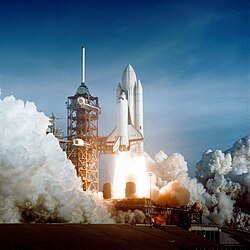
Beginning with the industrial revolution, the U.S. became a world leader in the design, production, and selling of products and services. The United States is now one of the most influential countries in scientific and technological research and the production of innovative technological products. The bulk of Research and Development funding (69 %) comes voluntarily from the private sector, rather than from taxation.[80] During World War II, the U.S. led the Allied program to develop the atomic bomb, ushering in the atomic age. Beginning early in the Cold War, as a response to USSR's space program, the U.S. pursued a wide and successful space program of its own, through the federaly funded NASA program. This competition between the two superpowers, dubbed the Space Race, led to rapid advances in rocketry, material science, computers, and many other areas. The U.S. was also the most instrumental nation in the development of the Internet, while also developing its predecessor, Arpanet. The United States has become a world leader in science, producing the largest percentage of scientific research papers of any country.[81] Many scientists from across the world have come to work in the United States, a very notable example being Albert Einstein. There are also a number of famous American-born scientists, such as the physicist Richard Feynman, who helped develop quantum electrodynamics, and James D. Watson, who helped discover the structure of DNA. The U.S. continues to lead the way in all fields of innovation, industry and science.
Transportation
The United States has a variety of freeway and highway systems, multiple large international airports, and an extensive freight rail network. The automobile industry developed early and more rapidly in the United States. As the largest developed nation, the U.S. is home to more roadways than any other country in the world.[82] Although mass transit systems are commonplace in some large cities, these systems tend to be less extensive than in other developed nations.[83]
Air travel is the preferred mode of transport for long distances. In terms of passengers, seventeen of the world's thirty busiest airports in 2004 were in the U.S., including the world's busiest, Hartsfield – Jackson Atlanta International Airport (ATL). In terms of cargo, in the same year, twelve of the world's thirty busiest airports were in the U.S., including the world's busiest, Memphis International Airport - Federal Express's superhub. The airline industry is privately owned; however, most airports are government owned.
Several major seaports are in the United States, on the east (New York/New Jersey), west (Long Beach/Los Angeles and Oakland) and gulf coasts (Houston).[84] The interior of the U.S. also has major shipping channels, via the St. Lawrence Seaway and the Mississippi River. The first water link between the Great Lakes and the Atlantic, the Erie Canal, allowed the rapid expansion of agriculture and industry in the Midwest and made New York City the economic center of the country.
Demographics
| Demographics of the United States | |
|---|---|
| Population[85] | |
| Population | 300,000,000 |
| Population growth | 0.59% |
| Illegal immigrants | 12,000,000 |
| Citizens abroad | 3,000,000 to 7,000,000 |
| Race[86] | |
| White | 74.67% |
| African American | 12.12% |
| Asian and Pacific Islander | 4.46% |
| Other | 5.99% |
| Affluence[87][88] | |
| Persons w/ six figure incomes | 5.63% |
| Top 10% of individuals | $75,000 |
| Households w/ six figure incomes | 17.2%. |
| Top 10% of households | $118,200. |
| Languages[7][89] | |
| English (only) | 214.8 million |
| Spanish | 29.7 million |
| Chinese | 2.2 million |
| French incl. Creole | 1.4 million |
| Tagalog | 1.3 million |
| German | 1.1 million |
| Vietnamese | 1.1 million |
| SOURCE: U.S. Department of Commerce | |
On October 17, 2006 at 7:46 a.m. EST, the United States' population stood at an estimated 300,000,000.[85] This figure excludes persons living in the U.S. illegally. Due to the nation's size any population estimate needs to be seen as a somewhat rough figure, according to the U.S. Department of Commerce.[90] According to the 2000 census, about 79 percent of the population lived in urban areas.[91] The United States has a highly diverse population, being home to 31 ethnic groups with more than a million members.[92] Among racial demographics, whites, who are of European ancestry, remained the largest racial group[86] with German-Americans, Irish-Americans and English-Americans constituting the three largest ethnic groups.[93] The percentages of whites among the general population is, however, declining.[7] African Americans, who are largely the descendants of former slaves, constituted the nation's largest racial and third largest ethnic minority.[86][94]
Demographic trends include the immigration of Hispanics from Latin America into the Southwest, a region that is home to about 60 percent of the 35 million Hispanics in the United States. Immigrants from Mexico make up about 66 percent of the Hispanic community and are the second largest ethnic group in the country.[95] It is estimated that with current population trends non-Hispanic Whites will become a plurality by 2040 to 2050. In the four "majority-minority states" such as California,[96] New Mexico,[97] Hawaii[98] and Texas[99] such is already the case.
Crime in the United States is characterized by relatively high levels of gun violence and homicide, compared to other developed countries.[100][101] Levels of property crime and other types of crime in the United States are comparable to other developed countries.[102]
Indigenous peoples
The Indian Citizenship Act of 1924 gave United States citizenship to Native Americans, in part because of an interest by many to see them merged with the American mainstream, and also because of the service of many Native American veterans in the First World War.
According to the 2003 census estimates, there are 2,786,652 Native Americans in the United States.
Languages
Although the United States has no official language at the federal level, English is the de facto national language. In 2003, about 215 million, or 82 percent of the population aged five years and older, spoke only English at home.[103] English is the most common language for daily interaction among both native and non-native speakers. Knowledge of English is required of immigrants seeking naturalization. More languages are, however, used in daily life. Spanish is the second most spoken language and the most widely taught foreign language.[104][105] Some Americans advocate making English the official language, which is the law in twenty-five states.[106] Three states also grant administrative status to languages other than English: Hawaiian in Hawaii (where it is granted official status by the Hawaiian Constitution), French in Louisiana, and Spanish in New Mexico (where the languages are not official but are promoted and preserved through several legislative acts).[107][108][109]
Largest cities
The largest cities of the United States figure prominently in the economy, culture, and heritage of the U.S. In 2005, 254 incorporated places in the U.S. had populations greater than 100,000, nine cities had populations greater than one million, and four global cities had populations greater than 2 million (New York City, Los Angeles, Chicago, and Houston).[110] The United States has 54 metropolitan areas with populations greater than one million.[111] Miami, Washington, Atlanta, and Detroit are examples of cities whose populations of the cities proper are not in the top 10 in the U.S. but whose metropolitan areas rank in the top 10.
| Rank | City | Population within city limits (2005) | Population Density per sq mi | Metropolitan Area | Region | |
|---|---|---|---|---|---|---|
| population (2006) | rank | |||||
| 1 | New York City | 8,143,197 | 26,720.9 | 18,818,536 | 1 | Northeast |
| 2 | Los Angeles | 3,844,829 | 8,198.0 | 12,950,129 | 2 | West |
| 3 | Chicago | 2,842,518 | 12,750.3 | 9,505,748 | 3 | Midwest |
| 4 | Houston | 2,016,582 | 3,371.7 | 5,539,949 | 6 | South |
| 5 | Philadelphia | 1,463,281 | 11,233.6 | 5,826,742 | 5 | Northeast |
| 6 | Phoenix | 1,461,575 | 2,782.0 | 4,039,182 | 13 | Southwest |
| 7 | San Antonio | 1,256,509 | 2,808.5 | 1,942,217 | 29 | Southwest |
| 8 | San Diego | 1,255,540 | 3,771.9 | 2,941,454 | 17 | Southwest |
| 9 | Dallas | 1,213,825 | 3,469.9 | 6,003,967 | 4 | South |
| 10 | San Jose | 912,332 | 5,117.9 | 1,787,123 | 30 | West |
Religion

The United States government keeps no official register of Americans' religious status.[112] However, in a private survey conducted in 2001 and mentioned in the Census Bureau's Statistical Abstract of the United States, 76.7 percent of American adults identified themselves as Christian; about 52 percent of adults described themselves as members of various Protestant denominations. Roman Catholics, at 24.5 percent, were the most populous individual denomination. The most popular other faiths include Judaism (1.4 percent), Islam (0.5 percent), Buddhism (0.5 percent), Hinduism (0.4 percent) and Unitarian Universalism (0.3 percent).[113] About 14.2 percent of respondents described themselves as having no religion. The religious distribution of the 5.4 percent who elected not to describe themselves for the survey (up from 2.3 percent in 1990) is unknown. Although the total U.S. population grew by 18.5 percent between 1990 and 2001, 13 religious groups declined in absolute numbers, while 20 groups more than doubled in number.[114]
Education
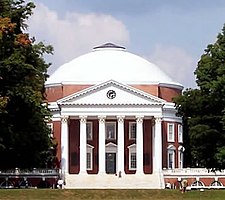
Education in the United States is a combination of public and private entities. Public education is the responsibility of state and local governments, rather than the federal government. The Department of Education of the federal government, however, exerts some influence through its ability to control funding. Students are generally obliged to attend school starting with kindergarten, and ending with the 12th grade, which is normally completed at age 18, but many states may allow students to drop out as early as age 16. Parents may also choose to educate their own children at home or to send their children to parochial or private schools.

After high school, most graduates voluntarily go on to community colleges, state colleges, private colleges, universities, or trade schools. Tuition for these institutions can range from $1000 to over $40,000 a year. Many American university students use student loans and public and private scholarships to pay their tuition. Many of these financial aid programs are subsidized by both federal and state governments. Public universities receive part of their funding from those same governments. Alumni donations and other sources also contribute large amounts of funding to both public and private universities, and most of the top university endowments in the world are owned by universities in the United States. Tuition at private universities is generally much higher than at public universities.
There are many competitive institutions of higher education in the United States, both private and public. The United States has 168 universities in the world's top 500, 17 of which are in the top 20.[115] There are also many smaller universities and liberal arts colleges, and local community colleges of varying quality across the country with open admission policies.
The United Nations assigned an Education Index of 99.9 to the United States, ranking it and 20 other nations as tied for the highest score.[116] The United States has a basic literacy rate at 98 percent[117] to 99 percent[118] of the population over age 15. As for educational attainment, 27.2 percent of the population aged 25 and above have earned a bachelor's degree or higher, and 84.6 percent have graduated high school.[119]
Health
The overall performance of the United States health care system was ranked 15th by the World Health Organization.[120] The United States far outspends (combined private and public expenditures) any other nation in healthcare, measured in terms of both per capita spending and percentage of GDP.[121] This spending has not correlated with a high ranking in many public health metrics. The CIA World Factbook indicates that the United States has a higher infant mortality rate and slightly lower life expectancy than some other post-industrial western nations such as Sweden,[122] Germany[123] or France.[124][125] The average salary of a physician in the U.S. is the highest in the world.[126] Obesity is a public health problem, estimated to cost tens of billions of dollars annually.[127]
Unlike some other Western countries, the U.S. healthcare system is not fully publicly-funded, instead relying on a mix of public and private funding. In 2004, private insurance paid for 36 percent of personal health expenditure, private out-of-pocket payments covered 15 percent, and federal, state, and local governments paid for 44 percent.[128]
In 2005, 41.2 million people in the U.S. (14.2 percent of the population) were without healthcare insurance for at least part of that year.[129] Many of these people may have been between jobs for part of the year, which could leave them without coverage as health insurance is often provided as a benefit of employment. Not all those without insurance were unable to afford it — approximately one third of the 41.2 million who were without insurance for part of the year lived in households with annual incomes greater than $50,000, with half of these having an income of greater than $75,000.[130] Presumably some of these people chose not to purchase insurance, for example because they perceived themselves as being at low risk of serious illness. Another third of the 41.2 million were eligible for public health insurance programs but had not signed up for them.[131] This leaves substantially fewer than 41.2 million people who were without access to healthcare insurance because they could not afford to purchase it privately. Although emergency care facilities are required to provide service regardless of the patient's ability to pay, medical bills remain the most common reason for personal bankruptcy in the United States.[132]
The nation spends a substantial amount on medical research, mostly privately-funded. As of 2000, non-profit private organizations funded 7 percent (such as the Howard Hughes Medical Institute), private industry funded 57 percent, and the tax-funded National Institutes of Health funded 36 percent of medical research in the U.S.[133] As of 2003, the NIH funded 28 percent of medical research funding; funding by private industry increased 102 percent from 1994 to 2003.[134]
Culture

The United States is a diverse and multicultural nation, home to a wide variety of ethnic groups and cultures.[5][7] The culture held in common among most Americans has evolved from that of colonial Dutch and English settlers, modified by a melting pot of various European cultures. English, German, and Irish cultures and later Italian, Greek, and Eastern European Jewish cultures were among the most significant influences on modern American culture. Descendants of enslaved West Africans preserved some cultural traditions from West Africa in the early United States. Geographical place names largely reflect the combined English, Dutch, French, German, Spanish, and Native American components of U.S. history.[7]
There are two main theories regarding the current evolution of American culture. In the traditional melting pot, immigrants from other cultures bring unique cultural aspects which are incorporated into the larger American culture and adopt features of the mainstream culture. A more recently articulated model is that of the salad bowl, in which immigrant cultures retain some of their unique characteristics while culturally intermingling.[135][7]
An important component of American culture is the American Dream: the idea that, through hard work, courage, and determination, regardless of social class, a person can gain a better life.[136]
Cuisine
American cuisine uses Native American ingredients such as turkey, potatoes, corn, and squash, which have become integral parts of American culture. Such popular icons as apple pie, pizza, and hamburgers are either derived from or are actual European dishes. Burritos and tacos have their origins in Mexico. Soul food, which originated among African slaves, is popular in the U.S. as well. However, many foods now enjoyed worldwide either originated in the United States or were altered by American cooks.
Visual arts
In the eighteenth and early nineteenth centuries American art took most of its cues from Europe. Painting, sculpture, and literature looked to Europe as a model, and for approval. By the end of the U.S. Civil War, a more native voice had emerged in American literature. Mark Twain, Emily Dickinson, and Walt Whitman all spoke in an American vernacular and voice. Visual art was slower to find its own distinct American expression. The 1913 Armory Show in New York City, an exhibition which brought European modernist artists' work to the U.S., both shocked the public and influenced art making in the United States for the remainder of the twentieth century. The exhibition had a twofold effect of communicating to American artists that art making was about expression, not only aesthetics or realism, and at the same time showing that Europe had abandoned its conservative model of ranking artists according to a strict academic hierarchy.
Literature
Americans have produced much notable literature across genres — its citizens have won the Nobel Prize in Literature twelve times. Toni Morrison became the most recent recipient in 1993. The genre of literature which captures the American essence in its narrative is the 'Great American Novel'. The term has been used to describe Herman Melville's Moby-Dick, Mark Twain's The Adventures of Huckleberry Finn, F. Scott Fitzgerald's The Great Gatsby, and J.D. Salinger's The Catcher in the Rye.
Music
Music also traces to the country's diverse cultural roots through an array of styles. Rock, pop, soul, hip hop, country, blues, and jazz are among the country's most internationally renowned genres. Since the late 19th century, popular recorded music from the United States has become increasingly known across the world, such that some forms of American popular music are heard almost everywhere.[137]
Cinema
The birth of cinema, as well as its development, largely took place in the United States. In 1878, the first recorded instance of sequential photographs capturing and reproducing motion was Eadweard Muybridge's series of a running horse, which the British-born photographer produced in Palo Alto, California, using a row of still cameras. Since then, the American film industry, based in Hollywood, California, has had a profound effect on cinema across the world. Other genres that originated in the United States and spread worldwide include the comic book and Disney's animated films.
Sports
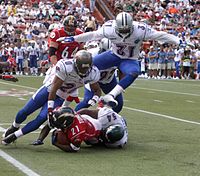
Sports are a national pastime, and playing sports, especially football, baseball, and basketball, is very popular. Youths are encouraged to participate in sports starting from pee-wee leagues, through high-school, into college and eventually culminating in Professional sports, which in the U.S. is a sizable business venture.[139] The "Big Four" sports are baseball, American football, ice hockey, and basketball.[140] Auto racing, particularly NASCAR, has also enjoyed a surge in popularity since the 1970s.
Eight Olympiads have taken place in the United States, with the premier Summer Olympics being held four times (St. Louis 1904, Los Angeles 1932 and 1984, and Atlanta 1996). In terms of medals won, the United States ranks second all-time in the Winter Games, with 216 (78 gold, 81 silver, and 59 bronze),[141][142] and first in the Summer Games, with 2,321 (943 gold, 736 silver, and 642 bronze).[143][144]


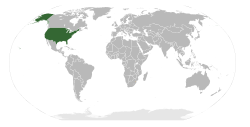




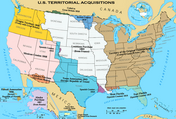








No comments:
Post a Comment